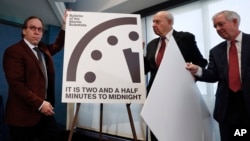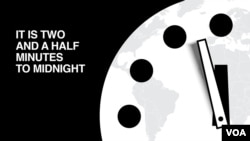Atomic scientists on Thursday moved the hands of their symbolic "Doomsday Clock" 30 seconds closer to midnight, in large part, they announced, because of the words of one man — President Donald Trump.
A physicist, a career ambassador and a retired navy admiral at the National Press Club presided over the annual unveiling of the cardboard clock, showing the hands now at two-and-a-half minutes to midnight, representing an increased risk of global disaster.
"This is historic. The clock has not been closer to midnight in 64 years," said Arizona State University theoretical physicist Lawrence Krauss.
“We’ve never moved the clock a half minute,” — a break from the full-minute ticks, explained Rachel Bronson, the executive director and publisher of the Bulletin of Atomic Scientists. "That’s because words do matter. The stakes are so high.”
Those unveiling the 2017 clock told reporters the rhetoric of newly-inaugurated Trump to impede progress in nuclear disarmament and climate change was a key factor in deciding the time change.
The new president, they acknowledge, also can single-handedly help send the hands of the Doomsday Clock moving backward to safety.
Providing an ‘opening’
"We have to give him the opening," former U.S. ambassador to Russia Thomas Pickering told VOA when asked whether he believes Trump will be swayed by news of the clock's advance to midnight. "Hopefully he will hear" the suggestions from scientists and others advocating a re-start of arms reduction talks with Russia and raising the alarm about the effects of climate change.
Other factors affecting the clock's movement this year are the growing risks from cyberattacks and emerging technologies in life sciences.
The Doomsday Clock has faced criticism over the decades as more art than science. Its "back and forth" movement is ridiculed, while the scientists behind it are labeled scaremongers.
"When it comes to nuclear weapons people have become complacent," Krauss told VOA. "So we owe it to the world to risk being labeled scaremongers just to encourage people to think about the problem."
The Doomsday Clock was created in 1947 by a group of concerned scientists who had been involved with the top secret Manhattan Project, which built the first nuclear weapons, as a response to nuclear threats.
Since then, the minute hand of the clock has moved backwards and forwards. Its closest warning of apocalypse was amid the commencement of atmospheric thermonuclear weapons testing in 1953 by the United States and Soviet Union.
The farthest the hands have moved from midnight was in 1991 when the clock read 11:43 p.m. following the Threshold Test Ban Treaty entering into force.









